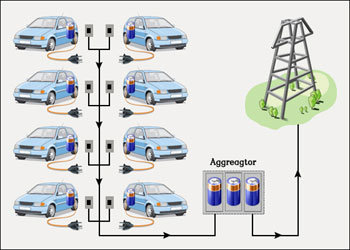For the first time, electric cars are feeding electricity to the grid and making money on it!
"It might be a few more years before a grid-integrated vehicle sits in every American driveway, but I’m excited to continue the journey," says Patrick Harker, University of Delaware President.
The idea, originally conceived by Amory Lovins, is to enable EV owners to sell electricity to the grid from their batteries while they are parked during the day. That electricity will be used to stabilize the grid to counteract the intermittency of wind and solar.
Since late February, NRG Energy’s eV2g technology is connected to the PJM Interconnection, which serves 60 million people in the 13 mid-Atlantic states. It’s linked to PJM’s frequency regulation market, which balances supply and demand on the grid second-by-second.
In 2011, NRG joined with the University of Delaware to commercialize a two-way interface between electric cars and the power grid – it enables vehicle owners to sell electricity to the grid while they charge their cars.

eV2g allows EVs to communicate with the grid and lets grid operators take power from connected EVs during peak usage periods. EV owners can schedule in advance any times their vehicles need more charging than usual, as for a unusually long trip, and the minimum level of charge they want to maintain at all times. eV2g collects payment from the grid operator and pays EV owners for making their vehicles available.
Importantly, the technology aggregates power from multiple electric vehicles to create one larger power resource, rather than individual, smaller ones.
Initially, eV2g will help managers of commercial electric fleets by providing revenue while the vehicles are parked, with individual EV owners to eventually follow. The system is currently in development with restricted test fleets and is not yet offered commercially.
"This demonstrates that EVs can provide both mobility and stationary power while helping making the grid more resilient and ultimately generating revenue for electric vehicle owners," says Denise Wilson, who leads emerging businesses at NRG. "The advancement also proves the power of partnerships such as these to accelerate the development of clean energy technologies that will deliver for the economy, consumers, security and sustainability."
To make this possible, PJM lowered the minimum amount required for a grid connection because batteries provide faster, more accurately responding resources. "We knew that would attract innovation," says Michael Kormos, senior vice president of PJM Operations.
This technology can also be used to power homes and buildings.
"The energy storage inherent in automobiles is staggering. If all the automobiles in the U.S. were electrified it would be enough to power the entire U.S. for half a day. The strategic partnership between NRG and University of Delaware provides the opportunity to tap this enormous potential thereby enhancing energy security, facilitating integration of renewables and lowering the cost of electricity," says David Weir, Director of University of Delaware’s Office of Economic Innovation and Partnerships..
